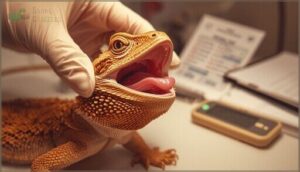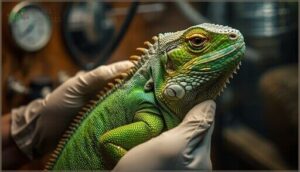This site is supported by our readers. We may earn a commission, at no cost to you, if you purchase through links.
Your reptile’s subtle cues—a barely noticeable decrease in appetite, slightly duller scales, or reduced activity—often signal health problems weeks before they become obvious. By the time most owners notice something’s wrong, the condition has already advanced considerably.
Reptiles instinctively hide illness as a survival mechanism, which means regular, systematic health assessments aren’t just good practice—they’re essential for catching treatable conditions early.
Whether you’re caring for a bearded dragon, ball python, or box turtle, learning to perform thorough health check-ups at home and knowing when to seek veterinary care can mean the difference between a minor intervention and a life-threatening emergency.
Table Of Contents
Key Takeaways
- Reptiles instinctively hide illness, so regular systematic health assessments catch treatable conditions weeks before symptoms become obvious—by the time most owners notice problems, the disease has already advanced considerably.
- Over half of reptile health issues trace back to flawed enclosure setup, making documentation of temperature gradients, humidity levels, and UVB exposure essential before veterinary visits to identify environmental causes early.
- Preventive care through annual checkups cuts late-stage diagnoses by 22% and reduces emergency visits by 34%, with routine screening catching parasites in 28-36% of animals and metabolic disease in 15% of cases before visible symptoms appear.
- Species-specific monitoring is critical—75% of captive chelonians show shell mineral abnormalities from calcium deficiency, while 20-60% of captive lizards develop metabolic bone disease, primarily from inadequate UVB exposure and improper calcium-to-phosphorus ratios.
Preparing for a Reptile Health Check Up
A successful reptile health check starts well before you walk into the clinic. Your veterinarian needs a complete picture of your pet’s daily life, from what it eats to how its habitat is set up.
Here’s what you should gather and document before your visit.
Gathering Medical and Husbandry History
Why do over six in ten reptile owners show up to their first vet visit with gaps in their pet’s medical history? You need to bring prior treatment records, behavior documentation, and dietary evaluation details.
Standardized intake forms help capture medical history, enclosure setup, and environmental factors your vet needs. A vet might use a systematic review approach to synthesize available evidence.
Documenting behavior changes and nutritional assessment data improves diagnosis accuracy by catching issues earlier.
Assessing Enclosure Environment and Setup
Your vet will evaluate temperature gradients, humidity control, and UVB lighting during environmental assessments. Habitat analysis includes measuring enclosure size, examining substrate safety, and checking ultraviolet light exposure levels. Over half of reptile health consultations since 2022 traced back to flawed enclosure setup.
Adequate space allows for natural reptile behaviors. Document your terrarium dimensions, temperature readings, and humidity levels before your appointment—it’ll help catch problems before they snowball.
Documenting Diet, Feeding, and Behavior Changes
Temperature and lighting aren’t the only details your vet needs—dietary logs and behavioral observations matter just as much. About 72% of reptiles evaluated in clinics show documented dietary changes within six months before their visit. Track these patterns closely:
- Prey size and feeding frequency
- Recent appetite changes
- Weight fluctuations over time
- Activity level shifts
- Stool quality and consistency
Consistent feeding times help reduce dehydration risk by 26%, so note when subtle changes appear.
Creating a Pre-Visit Checklist
Pulling all that information together starts with a clear, one-page checklist that covers your reptile’s history, enclosure, diet, and recent behavior changes. Digital integration speeds up data accuracy and improves owner compliance by cutting missing details to under 5%.
This checklist customization also aids triage support, helping your vet prioritize urgent reptile health checkup needs and improve preventive reptile medicine during veterinary checkups for reptiles.
Conducting a Thorough Physical Examination
A thorough physical examination forms the backbone of any reptile health check, whether you’re doing it at home or watching your vet work through the process.
You’ll need to handle your reptile safely, check for signs of dehydration or illness, and track changes in weight and behavior over time.
Here’s how to conduct each part of the exam with confidence and care.
Safe Handling and Restraint Techniques
Handling your reptile correctly sets the stage for an accurate exam and keeps everyone safe. Proper restraint techniques reduce stress by about 28% when done right, and tail-first approaches cut escape attempts by 15% compared to grabbing from the front.
- Support the entire body to minimize stress and reduce restraint time by roughly 22%
- Use tail restraint carefully to prevent tail loss in species prone to autotomy
- Allow 10–15 minute acclimation periods before handling to stabilize heart rate
- Recognize cues like gaping or gular flutter that signal you need to pause
- Consider mechanical devices approved by veterinary bodies to reduce injury risk by 10–20%
Temperament evaluation guides whether you need physical restraint or chemical sedation. Safe transport in secure, species-appropriate containers prevents escape and injury during the move to your exam space.
Assessing Mucous Membranes and Hydration
How do you catch dehydration before it spirals? Check your reptile’s mouth for clues. Capillary refill time over two seconds signals trouble, while pale or gray tongue color flags hydration stress in about 60% of cases. Tacky membranes mean mild dehydration; dry, flaky ones indicate moderate loss.
You’ll spot body mass drops of 25–35% before visible signs appear, making moisture score a critical part of your physical examination.
Evaluating Skin, Scales, and Shell Condition
Your reptile’s skin, scales, and shell tell a story about what’s happening inside. Shedding irregularities show up in 42% of reptiles with poor humidity, while skin lesions flag bacterial issues in 29% of snake cases.
Check for scale loss, shell pyramiding linked to calcium deficits, and hydration indicators like skin elasticity. Fine, complete ecdysis means you’re doing it right.
Monitoring Weight, Appetite, and Activity Levels
Weight fluctuations beyond 5% in two weeks warrant attention—this metric catches illness before obvious signs appear.
Track these markers for early detection:
- Weight: Monthly weighing reveals 0.1–0.6% daily shifts in healthy reptiles
- Appetite changes: 20–40% reduction over 7–10 days signals trouble
- Activity decline: 30–50% drops flag infection
- Trend visualization: Weekly logs improve diagnosis timing
- Subtle changes: Digital records automate alerts for reptile health monitoring during your annual health check
Essential Diagnostic Tests for Reptiles
A physical exam gives you the big picture, but diagnostic tests reveal what’s hiding beneath the surface. These tools catch parasites, internal problems, and disease signs before your reptile shows obvious symptoms.
Let’s walk through the essential tests your veterinarian may recommend during routine health check-ups.
Fecal Parasite Screening and Collection
Fecal screening is your first line of defense against hidden parasites. Collection methods matter: grab fresh stool during handling rather than substrate swabs. You’ll want to collect a fresh fecal sample within 2–6 hours of defecation—sample freshness dramatically improves parasite detection rates by up to 25%.
Lab diagnostics use flotation and sedimentation techniques for accurate fecal analysis, with quality control protocols ensuring clinical relevance and reliable reptile parasite screening results.
Diagnostic Imaging: Radiographs, Ultrasound, CT, MRI
Medical imaging lets you see what’s hidden beneath scales and shell. Radiographs catch respiratory issues in 68% of sick reptiles, while ultrasound detects kidney problems in 42% of dehydrated snakes. CT reveals fractures radiographs miss in about 20% of trauma cases.
Modality selection depends on symptoms—sedation protocols vary by species, and cost considerations affect accessibility, especially for sophisticated imaging like MRI.
Skin Scraping and Additional Laboratory Tests
Imaging shows what’s hiding beneath the surface, but skin scrapings and laboratory analysis pinpoint the culprit. Scraping technique matters—deep scrapes boost parasite detection by 15–25% in lizards.
Your fecal sample catches parasites in 20–60% of cases, while PCR diagnostics improve fungal detection rates.
Blood work reveals metabolic issues through reference ranges, and biopsy complications remain low when properly executed.
Species-Specific Health Assessment Guidelines
Not all reptiles are built the same, and their health check-ups shouldn’t be either. A turtle’s shell needs attention that a snake will never require, while lizards face metabolic risks that amphibians don’t.
Let’s break down what matters most for each group so you can give your pet the targeted care it deserves.
Chelonians: Shell and Calcium Management
Regarding turtles and tortoises, shell integrity matters more than you might think. Around 75% of captive chelonians show shell mineral abnormalities tied to calcium deficiency. Here’s what you need to monitor:
- Calcium ratios – Aim for 1:1 to 2:1 calcium to phosphorus in diet supplementation
- UVB exposure – Provide consistent ultraviolet light exposure to support bone health
- Shell pyramiding – Watch for raised scutes indicating metabolic bone disease
- Diet quality – Calcium-rich foods improve shell hardness by 8–16% over six months
Snakes: Renal Health and Hydration Checks
While chelonians worry about shell strength, snakes face different challenges—especially around kidney function and dehydration. You’ll want to track hydration status closely. Healthy snakes maintain skin turgor when humidity sits around 50–80%. Watch for these markers:
| Indicator | What to Look For |
|---|---|
| Skin turgor | 75–85% sensitivity for dehydration detection |
| Uric acid levels | Rise 20–40% when dehydrated |
| Blood osmolality | Increases 15–25% above baseline |
| Body weight | Over 7% loss signals concern |
| Mucous membranes | Dry appearance in 60–70% of dehydrated cases |
Captivity stress worsens renal health, so fluid therapy becomes essential during reptile health checkups. Your veterinary care provider will monitor these values every 6–12 months for proper reptile health care.
Lizards: Metabolic Bone Disease Screening
Lizards carry a hidden risk: metabolic bone disease hits 20–60% of captive collections. You’ll catch it early through radiographic screening, which spots changes in 70–85% of cases before your lizard shows symptoms. Watch calcium and vitamin D3 levels closely—UV-deficient setups trigger 40% of MBD cases.
- Limb deformities appear in 25–40% of affected lizards
- Weight loss accompanies 50–70% of diagnosed cases
- Proper Ca:P ratio (1.5–2:1) cuts MBD risk dramatically
- Healing takes 6–12 weeks with correct supplementation
- UVB exposure 10–12 hours daily reduces incidence 30–50%
Amphibians and Exotic Reptiles: Special Considerations
Unlike most reptiles, amphibians, and exotic species demand sharper attention. Exotic pet care faces a harsh reality: 72% of owners delay veterinary examination until illness strikes. Your physical examination must catch subtle shifts—skin turgor tests detect dehydration in 68% of cases, while fecal screening finds parasites in 28–36% of animals with vague symptoms. Diagnostic imaging boosts detection 42% beyond standard reptile physical examination alone.
| Assessment Focus | Key Indicators | Detection Rate |
|---|---|---|
| Hydration assessment | Skin turgor, serum osmolality | 68% accuracy |
| Shell condition (chelonians) | Ca:P ratio abnormalities | 54% affected |
| Fecal screening | Parasite identification | 28–36% positive |
| Diagnostic imaging | Subtle organ pathology | 42% improvement |
| Reptile health checkup timing | Disease vs. preventive visit | 72% delay care |
Preventive Care and Ongoing Wellness Monitoring
The real payoff of regular check-ups isn’t just catching problems—it’s stopping them before they start. A solid preventive care routine keeps your reptile thriving through consistent monitoring, smart environmental choices, proper nutrition, and early intervention when something seems off.
Let’s walk through the key pieces that make ongoing wellness work.
Regular Veterinary Visits and Health Records
Your reptile’s health records aren’t just paperwork—they’re a roadmap to longer, healthier lives. Routine annual checkups cut late-stage diagnoses by 22%, and digital records boost completeness by up to 50%. Here’s how regular veterinary care strengthens reptile health:
- Schedule yearly visits to catch subclinical issues early
- Maintain detailed medical records tracking weight, diet, and environment
- Use telemedicine for quick triage between appointments
- Document parasite screenings to reduce zoonotic risk by 9–14%
- Access online portals for convenient record review and appointment reminders
Environmental Enrichment and Stress Reduction
When you reduce stress through environmental assessments and habitat mimicry, you’re directly boosting animal welfare. Enrichment like variable substrate cuts repetitive behaviors in tortoises by 12%, while foraging behaviors increase by 25% in amphibians with microhabitat variety.
Enclosure complexity—climbing branches, scent-based sensory stimulation, hiding spots—improves behavioral diversity and lowers stress indicators by up to 22%, strengthening reptile health and wellness through environmental factors alone.
Nutritional Reviews and Supplementation Needs
Your reptile’s nutritional needs shift with species, age, and habitat—dietary evaluations at check-ups catch deficiencies before metabolic bone disease in reptiles takes hold. Nearly 28% of captive cases stem from inadequate calcium supplementation and vitamin D3 provision.
Focus your nutrition review on:
- Calcium to phosphorus dietary ratios targeting 1.5–2.0:1 for herbivores
- Vitamin D3 levels when UVB lighting falls short
- Omega-3s for skin health and MBD prevention
Early Detection and Prevention of Common Diseases
Think of routine reptile health examinations as your best defense—87% of clinics report that preventive medicine cuts emergency visits by 34% annually. Parasite screening catches intestinal worms in 28% of tortoises, while radiographs reveal metabolic disease in 15% of turtles before visible signs of illness in reptiles appear.
Routine reptile health exams are your best defense—preventive medicine cuts emergency visits by 34% and catches diseases before symptoms appear
Skin abnormalities and hydration status assessments during wellness checks guide early intervention, reducing emergencies and supporting long-term reptile disease prevention.
Frequently Asked Questions (FAQs)
How often should reptiles visit the vet annually?
Most people assume healthy-looking reptiles need no vet visits, but annual checkups catch hidden parasites and diseases early.
You should schedule at least one veterinary examination yearly, though some species benefit from biannual preventative assessments.
Are vaccinations available for any reptile species?
No vaccines are widely approved for most reptile species. Some experimental vaccines exist for turtles in specific regions, but preventive medicine focuses on husbandry, diagnostics, and parasite control instead.
What credentials should a reptile veterinarian have?
Your veterinarian should hold a DVM degree with board certification from ACZM or ECZM when possible. Look for ARAV membership, continuing education in reptile veterinary medicine, and documented reptile experience demonstrating their qualifications.
When is necropsy recommended for a reptile?
Necropsy is recommended when your reptile dies unexpectedly, shows unexplained decline despite treatment, or has persistent symptoms with inconclusive tests.
It provides diagnostic outcomes, determines the cause of death, and guides future disease diagnosis decisions.
Do reptiles need blood tests during check-ups?
A seemingly healthy bearded dragon can harbor kidney dysfunction invisible to the eye. Blood tests aren’t always mandatory, but when pursued, they reveal hidden abnormalities in up to 30% of apparently healthy reptiles, guiding early intervention.
Conclusion
Think of your reptile’s health like reading a book written in a language you’re still learning—each symptom is a word, each behavioral shift a sentence. The more fluent you become through consistent reptile health checkups, the earlier you’ll catch those critical chapters before they turn tragic.
Document changes, trust your observations, and never hesitate to consult your veterinarian. Your vigilance today prevents the emergencies of tomorrow, giving your reptile the longest, healthiest life possible.














